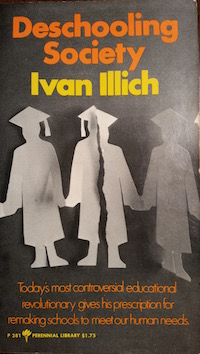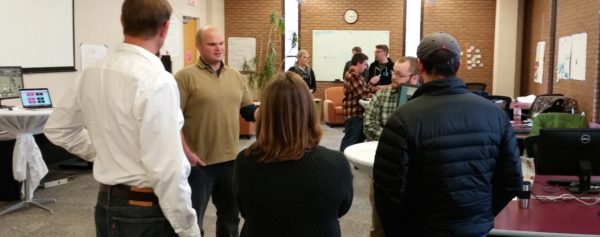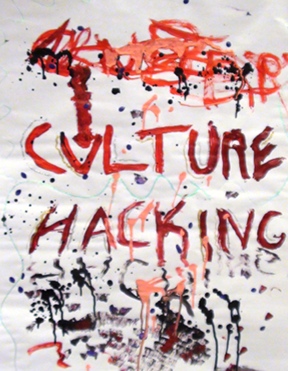 Some have said that the mind is like a parachute. It has to be open in order to function. Contrasting that, the street wisdom I’ve heard is that if you keep your mind open, people will throw their garbage in it. Certainly openness is a virtue, and in what way and what context?
Some have said that the mind is like a parachute. It has to be open in order to function. Contrasting that, the street wisdom I’ve heard is that if you keep your mind open, people will throw their garbage in it. Certainly openness is a virtue, and in what way and what context?
There have been a number of articles in my blog about Agile Software Development, and in this entry we’ll take a look at the project management framework called OpenAgile, which might help us also understand the meaning and value of “open”. And much like in software development we help to manage it using software deployment, making it available to everyone, we can understand the value of “open”.
Before we talk about OpenAgile we need to set the stage. If you’ve been involved to any depth in any human affair, there’s going to be some dirty laundry. It doesn’t matter if it’s a family, or a business, or a charity. Agile Software Development was intended to improve the bureaucratic and oppressive management structures in place in large corporate software development teams. Much like how sites like Fileproto.com try to open software up to the world, so too did we want to open up the discussion and integration between the development and the democracy that goes into making said software. To find out what goes into the development of an enterprise app, read Saleforce’s article on the state of development of such applications. That is why so many software developers prefered to work from home through companies such as Clevertech. I’m deeply grateful for the changes that this movement has made in my profession as a software developer even if there is still a long way yet to go. The most successful system under the “Agile” transformation umbrella has been by far, Scrum. Now as exciting and juicy as conflict and controversy can be, it can also be tawdry. So rather than digging into the trash for trash’s sake, I’ll only reflect some of what I know to help understand perhaps at least some of my interest in the OpenAgile framework.
Although Scrum appears to have roots that trace back to Japan in the 1980’s, most people credit Scrum for software development to Ken Schwaber, founder of both the Scrum Alliance and the Agile Alliance. Ken Schwaber’s book, Agile Software Development with Scrum, co-authored with Mike Beedle, is the standard reference (although many other books on Scrum have been written.) In 2010, my company SAP had Ken Schwaber speak to its employees and Ken personally claimed the “blame” for Scrum. But in 2009, the board of the very Scrum Alliance Ken had founded unanimously asked him to resign. It is quite interesting to read Ken’s account of his “resignation”, and his reasons for founding yet another organization. Another more recent resignation from the Scrum Alliance came from its Creative Director, Tobias Meyer.
 Both Tobias’s and Ken’s posts about their resignations speak to a conflict of vision contrasting mission against money. As a member myself of the Scrum Alliance, losing these two visionaries is a clear loss to the organization, and it raises many questions. And although it may be too soon to tell whether OpenAgile answers at least some of those questions, I’m very grateful that they’re trying to do so and that the appearance of the OpenAgile Institute on the scene will at the very least contribute to the conversation about these questions.
Both Tobias’s and Ken’s posts about their resignations speak to a conflict of vision contrasting mission against money. As a member myself of the Scrum Alliance, losing these two visionaries is a clear loss to the organization, and it raises many questions. And although it may be too soon to tell whether OpenAgile answers at least some of those questions, I’m very grateful that they’re trying to do so and that the appearance of the OpenAgile Institute on the scene will at the very least contribute to the conversation about these questions.
According to OpenAgile.com, the approach evolved out of Mishkin Berteig‘s work as an Agile software development consultant. It was also influenced by his father, Garry Mishkin’s teaching model, called the “Learning Circle”. Mishkin wanted to share this method for any type of work, and he wanted to share it in a collaborative way. He specifically wanted it to be like an open-source software project, thus he named it OpenAgile.
Having read the OpenAgile “Readiness Primer”, and having passed the “Readiness Test”, there is so much to love in OpenAgile. It simplifies much of the structure of iterative development while delineating in more detail many of the virtues required to make a team successful at getting work done collaboratively. I’m eager to learn more, yet this article wrestles with that sticky word, “Open”. How is OpenAgile Open? What does it mean to be Open?
The open-source movement attempted to free software developers from getting stopped by the barbed wire of patent law and copyright intellectual property claims by licensing the “source” code for software in a way that would allow others to copy and alter the “secret sauce” inside the software as long as they passed on the same open source license to all their users. This model has become extremely successful, and much of the worlds computers run this way. It engenders active user and developer communities who write code, find problems, fix problems, and give their fixes back to the community as a whole – usually without even getting paid for all their contributions.
On the face of it, OpenAgile is not “Open Source” in the common way of understanding it. The license on their website allows for people to copy and distribute the content, but not to alter or derive other works from it. In other words, if you see an improvement you might want to make to OpenAgile – you would be breaking the law to do so without getting permission from the OpenAgile Institute. I suspect that within the OpenAgile community, there is much more openness to collaboration. But this openness is not legally granted to the general public.
Before going any further, let’s take a pause and look deeper into openness. When I was going to college, I recall a  Woody Allen movie in which nine year old Alvy Singer stops doing his homework because the universe is expanding, which to him means that everything is going to break apart and so there’s no point to it all. In college there was also for me a lot of talk about entropy and the laws of thermodynamics, which basically says that a system tends towards maximum disorder. Everything eventually falls apart. It seemed a dismal but fundamental law of the universe. But after college I came across the work of Ilya Prigogene which really opened my mind (pun intended). It turns out that, yes, systems tend to fall apart – if they are closed. But all living systems are in fact open systems. They receive inputs in the form of sunlight, air, water, food, and they release what they don’t need. Open systems can in fact become more complex and develop higher and higher levels of order. They can evolve.
Woody Allen movie in which nine year old Alvy Singer stops doing his homework because the universe is expanding, which to him means that everything is going to break apart and so there’s no point to it all. In college there was also for me a lot of talk about entropy and the laws of thermodynamics, which basically says that a system tends towards maximum disorder. Everything eventually falls apart. It seemed a dismal but fundamental law of the universe. But after college I came across the work of Ilya Prigogene which really opened my mind (pun intended). It turns out that, yes, systems tend to fall apart – if they are closed. But all living systems are in fact open systems. They receive inputs in the form of sunlight, air, water, food, and they release what they don’t need. Open systems can in fact become more complex and develop higher and higher levels of order. They can evolve.
Perhaps this is why democracies have been much more vibrant and productive than closed societies, and why collaborative processes like Scrum and OpenAgile work. It certainly plays a part in the success of Open Space Technology about which I’ve written many times such as here and here and here. In an Open Space Technology style meeting or conference, the agenda is fully open to every attendee to talk about whatever they want to talk about. And every attendee is also free to come and go as they please. You can talk about whatever you want to, and you are given a chance to invite all the attendees to come to your session. This kind of openness enables the system to organize itself. It enables it to evolve.
In fact I only know about OpenAgile because of Open Space Technology (OST). It was at the amazing OST event, Scrum Beyond Software, that I first heard about OpenAgile. And then at the OST event, AgileOpen NorCal 2010 in San Francisco last October, I attended a presentation that David Parker gave about it. David is the current Executive Director of the OpenAgile Institute.
If it seems I’m being critical of OpenAgile, perhaps it is because I’m both disappointed by it and excited by it at the same time. I’d been fortunate enough to spend more time with David Parker at Lyssa Adkin’s most excellent Coaching Agile Teams class last November, and his enthusiasm about OpenAgile is infectious. The topics that OpenAgile covers, the virtues its extols, and even the books it recommends are excellent.
I hope that OpenAgile can grow more and more into the “open” that its name invokes. I asked David some of these questions at his session in San Francisco last year. How will the OpenAgile framework evolve? Will they give permission for derivative works to be generated? If not, how will the framework be open to submitted contributions? And how will the board of directors be constituted in the future? Will the membership be able to vote for the board members? Interestingly, the Agile Alliance gives members the opportunity to vote for board members. But the Scrum Alliance does not. This fact does not make me comfortable about the Scrum Alliance.
And here is one last question about the meaning and value of “open”. What place do certifications have in a dynamic open system? The Agile Alliance has made a specific policy not to pursue certifications. Harrison Owen did the same for Open Space Technology. Yet the presence of certifications helped make Scrum extremely popular by helping to spawn an industry of Certified Scrum Trainers. Isn’t it interesting that the financial success of Scrum certifications also seems to have led to the ejection of some of the foundational and creative forces behind Scrum such as Ken Schwaber and Tobias Meyer? Is there a way to have both certifications as well as openness?
Maybe there is no answer yet to these questions. And maybe, that’s also a part of openness – not always knowing the answer.

 A great deal of my blog has been devoted to my experience of the Agile Software Development movement and trying to apply this beyond just code. When I sought links from my blog to reference, so much of the last 10 years of my blog is about agility in one way or another. So I won’t bother adding links. Just scroll down, read, and click on the “older entries” link and you’ll find more, and yet more. All of my career has been focused on agile in one way or another.
A great deal of my blog has been devoted to my experience of the Agile Software Development movement and trying to apply this beyond just code. When I sought links from my blog to reference, so much of the last 10 years of my blog is about agility in one way or another. So I won’t bother adding links. Just scroll down, read, and click on the “older entries” link and you’ll find more, and yet more. All of my career has been focused on agile in one way or another. is a community based initiative to train and educate professional web developers. Montana businesses needs them. May 2015 it became the only topic at a
is a community based initiative to train and educate professional web developers. Montana businesses needs them. May 2015 it became the only topic at a  How have agile philosophy and practices been incorporated into the school? We start our 12 week class the first day by briefly explaining the
How have agile philosophy and practices been incorporated into the school? We start our 12 week class the first day by briefly explaining the 
 Jim McCarthy, author of the
Jim McCarthy, author of the 
 Most of you are probably familiar with the adage, “Physician, Heal Thyself!” The miracle of internet search revealed to me that this actually came from the New Testament as a quote of Jesus from an even older proverb. The meaning might seem to be transparent, which is that healers should use their own knowledge on themselves before attempting to use it on others.
Most of you are probably familiar with the adage, “Physician, Heal Thyself!” The miracle of internet search revealed to me that this actually came from the New Testament as a quote of Jesus from an even older proverb. The meaning might seem to be transparent, which is that healers should use their own knowledge on themselves before attempting to use it on others.




